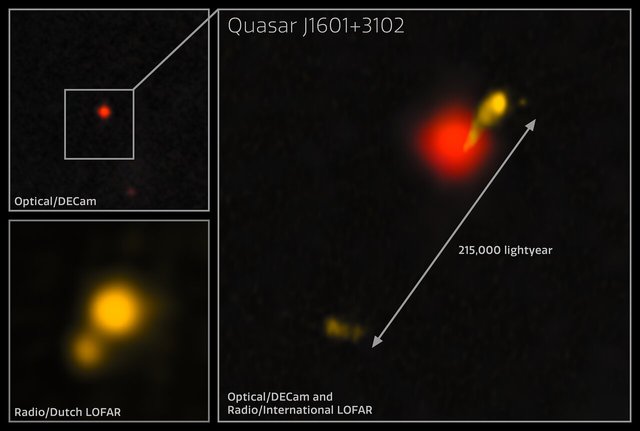A jet of matter covering twice the size of the Milky Way has been discovered/Localizan un chorro de materia que abarca el doble de la Vía Láctea

Source
As you all know, a black hole is a region of space where gravity is so intense that nothing, not even light, can escape from it. It forms when a sufficient amount of mass is concentrated in an extremely small volume, bending space-time in an extreme way according to Einstein's theory of general relativity. Although we cannot see them directly, astronomers identify them by their effect on nearby stars.
Como todos sabéis, un agujero negro es una región del espacio donde la gravedad es tan intensa que nada, ni siquiera la luz, puede escapar de ella. Se forma cuando una cantidad suficiente de masa se concentra en un volumen extremadamente pequeño, curvando el espacio-tiempo de manera extrema según la teoría de la relatividad general de Einstein. Aunque no podemos verlos directamente, los astrónomos los identifican por el efecto sobre estrellas cercanas.
A supermassive black hole is a type of black hole with a mass ranging from millions to billions of times the mass of the Sun, typically found at the center of most galaxies, including the Milky Way, where the supermassive black hole Sagittarius A* dominates the central region. When they absorb matter, they can form extremely hot accretion disks that emit light in X-rays and produce relativistic jets that expel matter at nearly the speed of light.
Un agujero negro supermasivo es un tipo de agujero negro con una masa que va desde millones hasta miles de millones de veces la masa del Sol, que normalmente se encuentran en el centro de la mayoría de las galaxias, incluida la Vía Láctea, donde el agujero negro supermasivo Sagitario A* domina la región central. Cuando absorben materia, pueden formar discos de acreción extremadamente calientes que emiten luz en rayos X y producir chorros relativistas que expulsan materia a casi la velocidad de la luz.

Source
Recently, a team of astronomers has discovered a jet of matter that extends at least 200,000 light-years, twice the diameter of the Milky Way. This is the largest jet ever observed in the early universe and is associated with a quasar called J1601+3102, which formed when the universe was less than 1.2 billion years old, about 9% of its current age.
Recientemente, un equipo de astrónomos ha descubierto un chorro de materia que se extiende al menos 200.000 años luz, el doble del diámetro de la Vía Láctea. Este es el chorro más grande jamás observado en el universo temprano y está asociado con un cuásar denominado J1601+3102, que se formó cuando el universo tenía menos de 1.200 millones de años, aproximadamente el 9% de su edad actual.
This discovery is significant because, although jets of matter are common in the nearby universe, they have been difficult to detect in the early and distant universe. The discovery of this massive jet provides valuable information about how and when the first jets in the universe formed and how they influenced the evolution of galaxies.
Este hallazgo es significativo porque, aunque los chorros de materia son comunes en el universo cercano, han sido difíciles de detectar en el universo temprano y lejano. El descubrimiento de este chorro masivo proporciona información valiosa sobre cómo y cuándo se formaron los primeros chorros en el universo y cómo influyeron en la evolución de las galaxias.

Source
The jet was initially identified using the Low Frequency Array (LOFAR), a network of radio telescopes in Europe. Follow-up observations in the near-infrared with the Gemini Near Infrared Spectrograph (GNIRS) and in the optical with the Hobby-Eberly Telescope provided a complete picture of the jet and the quasar that produces it.
El chorro fue identificado inicialmente utilizando el Telescopio Internacional LOFAR (Low Frequency Array), una red de radiotelescopios en Europa. Observaciones de seguimiento en el infrarrojo cercano con el Espectrógrafo de Infrarrojo Cercano de Gemini (GNIRS) y en el óptico con el Telescopio Hobby-Eberly permitieron obtener una imagen completa del chorro y del cuásar que lo produce.
The J1601+3102 jet is the largest found in the early universe, suggesting that these mechanisms were already at work shortly after the Big Bang. It also shows that an extremely large supermassive black hole is not necessary to generate jets of this magnitude.
El chorro de J1601+3102 es el más grande encontrado en el universo temprano, lo que sugiere que estos mecanismos ya estaban funcionando poco después del Big Bang. Además, demuestra que no es necesario un agujero negro supermasivo extremadamente grande para generar chorros de esta magnitud.
More information/Más información
https://www.space.com/monster-black-hole-early-universe-jet-twice-milky-way#:~:text=Astronomers%20have%20detected%20the%20largest,width%20of%20the%20Milky%20Way.